Marketing in Practice: Analyzing The Warehouse Group Strategies
VerifiedAdded on 2019/11/26
|20
|3200
|259
Report
AI Summary
This report provides a comprehensive analysis of The Warehouse Group's marketing strategies within the New Zealand retail industry. It begins with an executive summary outlining the paper's focus on the company's progress, strategies, and the business environment. The report then delves into the company's background, including its mission, vision, and organizational objectives. It examines the products and services offered, customer value proposition, and current market position. A detailed situational analysis is conducted, incorporating PEST analysis and an assessment of the competitive environment. The role of digital media in the company's marketing efforts is also discussed. Furthermore, the report explores target segmentation strategies and market segment profiles. The analysis highlights the importance of adapting to market dynamics and customer needs. The paper concludes with a summary of the key findings and provides a list of references.
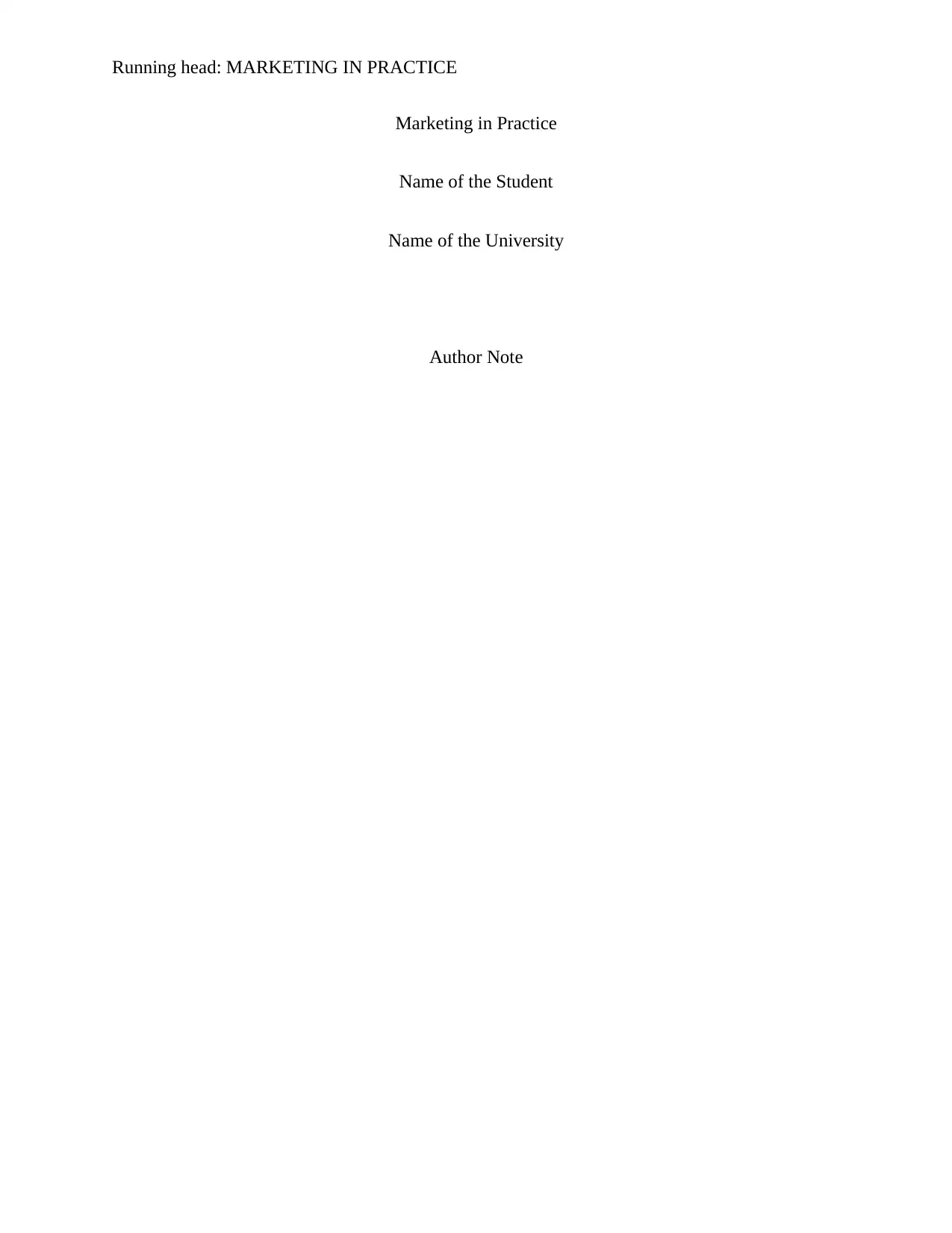
Running head: MARKETING IN PRACTICE
Marketing in Practice
Name of the Student
Name of the University
Author Note
Marketing in Practice
Name of the Student
Name of the University
Author Note
Paraphrase This Document
Need a fresh take? Get an instant paraphrase of this document with our AI Paraphraser
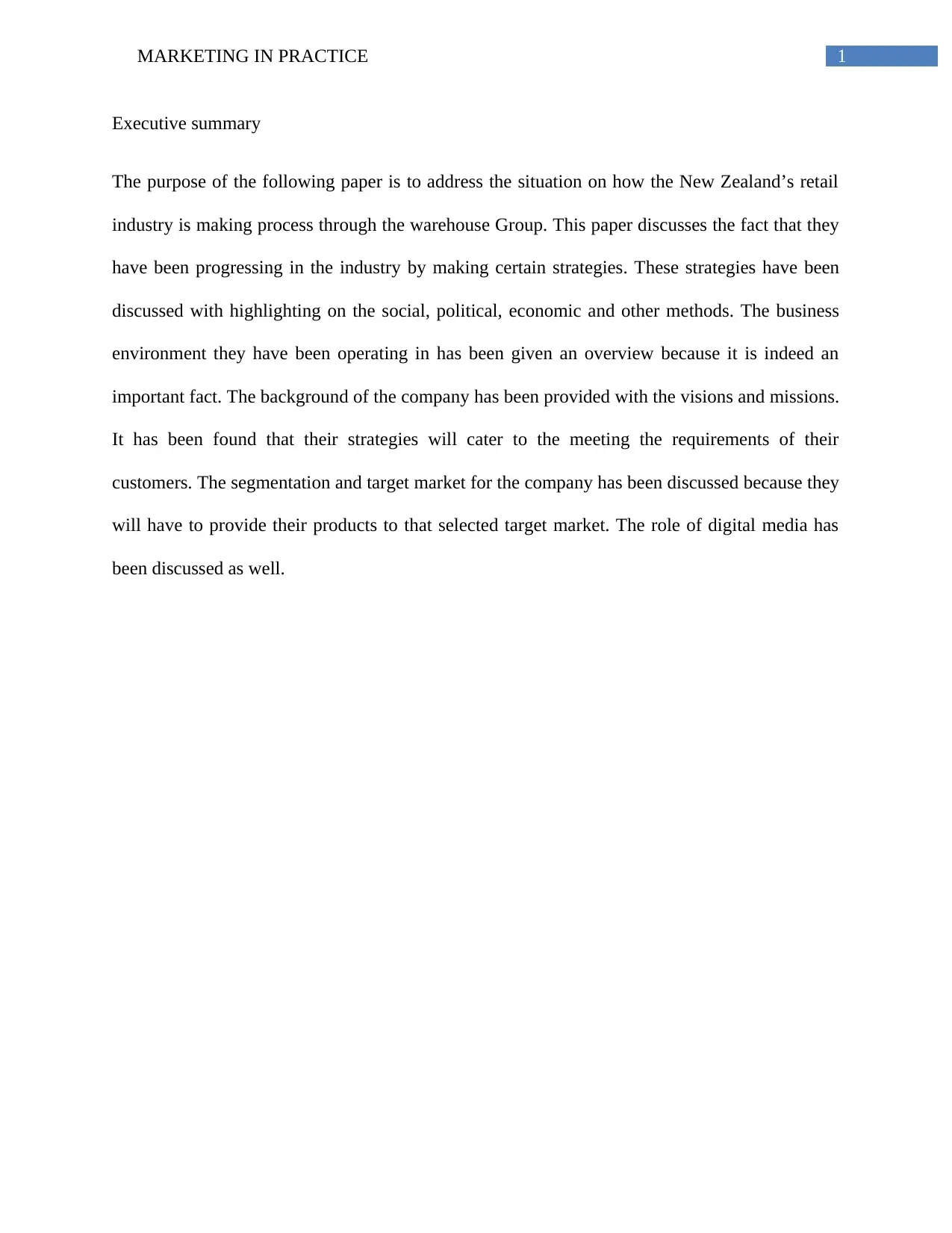
1MARKETING IN PRACTICE
Executive summary
The purpose of the following paper is to address the situation on how the New Zealand’s retail
industry is making process through the warehouse Group. This paper discusses the fact that they
have been progressing in the industry by making certain strategies. These strategies have been
discussed with highlighting on the social, political, economic and other methods. The business
environment they have been operating in has been given an overview because it is indeed an
important fact. The background of the company has been provided with the visions and missions.
It has been found that their strategies will cater to the meeting the requirements of their
customers. The segmentation and target market for the company has been discussed because they
will have to provide their products to that selected target market. The role of digital media has
been discussed as well.
Executive summary
The purpose of the following paper is to address the situation on how the New Zealand’s retail
industry is making process through the warehouse Group. This paper discusses the fact that they
have been progressing in the industry by making certain strategies. These strategies have been
discussed with highlighting on the social, political, economic and other methods. The business
environment they have been operating in has been given an overview because it is indeed an
important fact. The background of the company has been provided with the visions and missions.
It has been found that their strategies will cater to the meeting the requirements of their
customers. The segmentation and target market for the company has been discussed because they
will have to provide their products to that selected target market. The role of digital media has
been discussed as well.
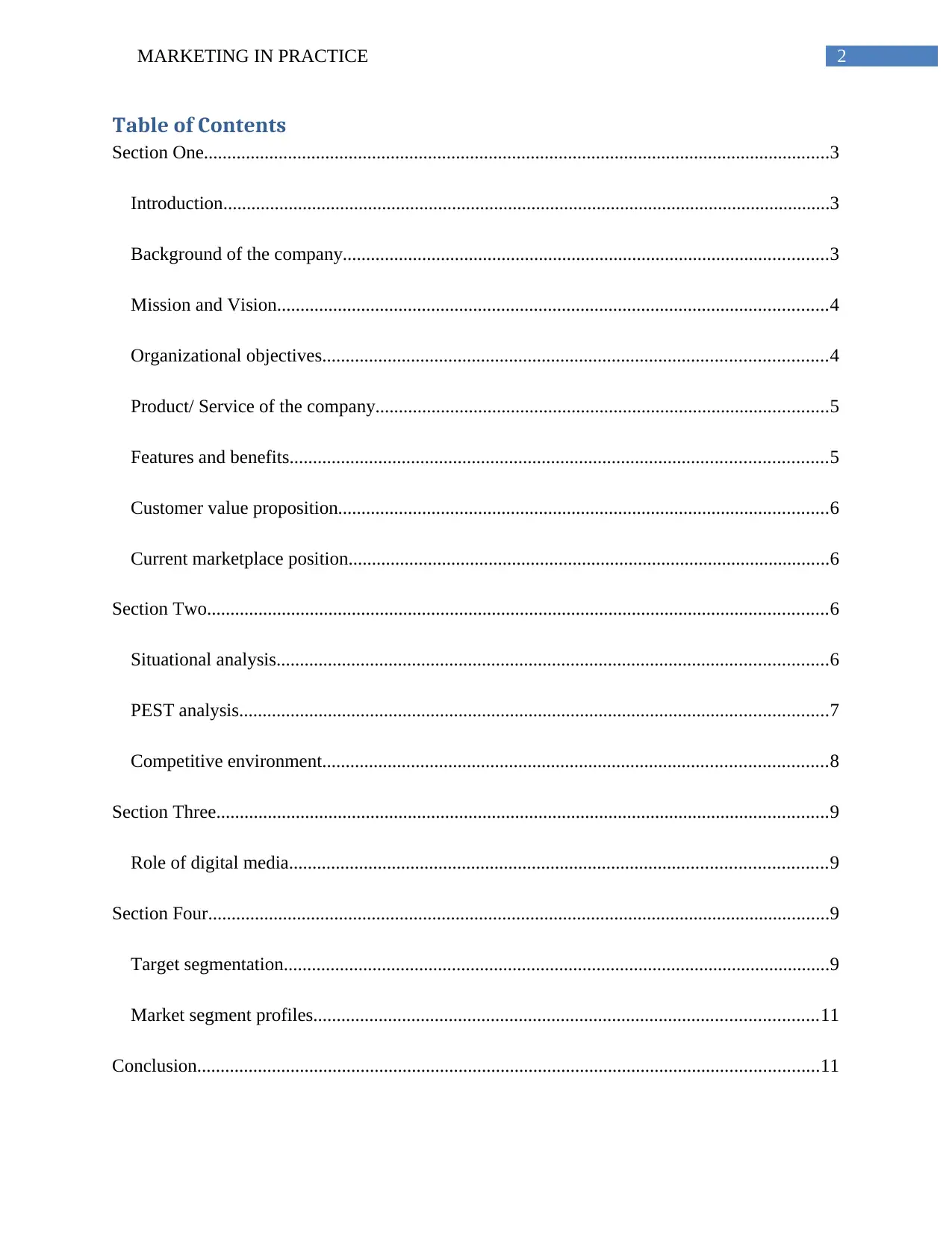
2MARKETING IN PRACTICE
Table of Contents
Section One......................................................................................................................................3
Introduction..................................................................................................................................3
Background of the company........................................................................................................3
Mission and Vision......................................................................................................................4
Organizational objectives............................................................................................................4
Product/ Service of the company.................................................................................................5
Features and benefits...................................................................................................................5
Customer value proposition.........................................................................................................6
Current marketplace position.......................................................................................................6
Section Two.....................................................................................................................................6
Situational analysis......................................................................................................................6
PEST analysis..............................................................................................................................7
Competitive environment............................................................................................................8
Section Three...................................................................................................................................9
Role of digital media...................................................................................................................9
Section Four.....................................................................................................................................9
Target segmentation.....................................................................................................................9
Market segment profiles............................................................................................................11
Conclusion.....................................................................................................................................11
Table of Contents
Section One......................................................................................................................................3
Introduction..................................................................................................................................3
Background of the company........................................................................................................3
Mission and Vision......................................................................................................................4
Organizational objectives............................................................................................................4
Product/ Service of the company.................................................................................................5
Features and benefits...................................................................................................................5
Customer value proposition.........................................................................................................6
Current marketplace position.......................................................................................................6
Section Two.....................................................................................................................................6
Situational analysis......................................................................................................................6
PEST analysis..............................................................................................................................7
Competitive environment............................................................................................................8
Section Three...................................................................................................................................9
Role of digital media...................................................................................................................9
Section Four.....................................................................................................................................9
Target segmentation.....................................................................................................................9
Market segment profiles............................................................................................................11
Conclusion.....................................................................................................................................11
⊘ This is a preview!⊘
Do you want full access?
Subscribe today to unlock all pages.

Trusted by 1+ million students worldwide

3MARKETING IN PRACTICE
References......................................................................................................................................13
Appendix........................................................................................................................................15
References......................................................................................................................................13
Appendix........................................................................................................................................15
Paraphrase This Document
Need a fresh take? Get an instant paraphrase of this document with our AI Paraphraser
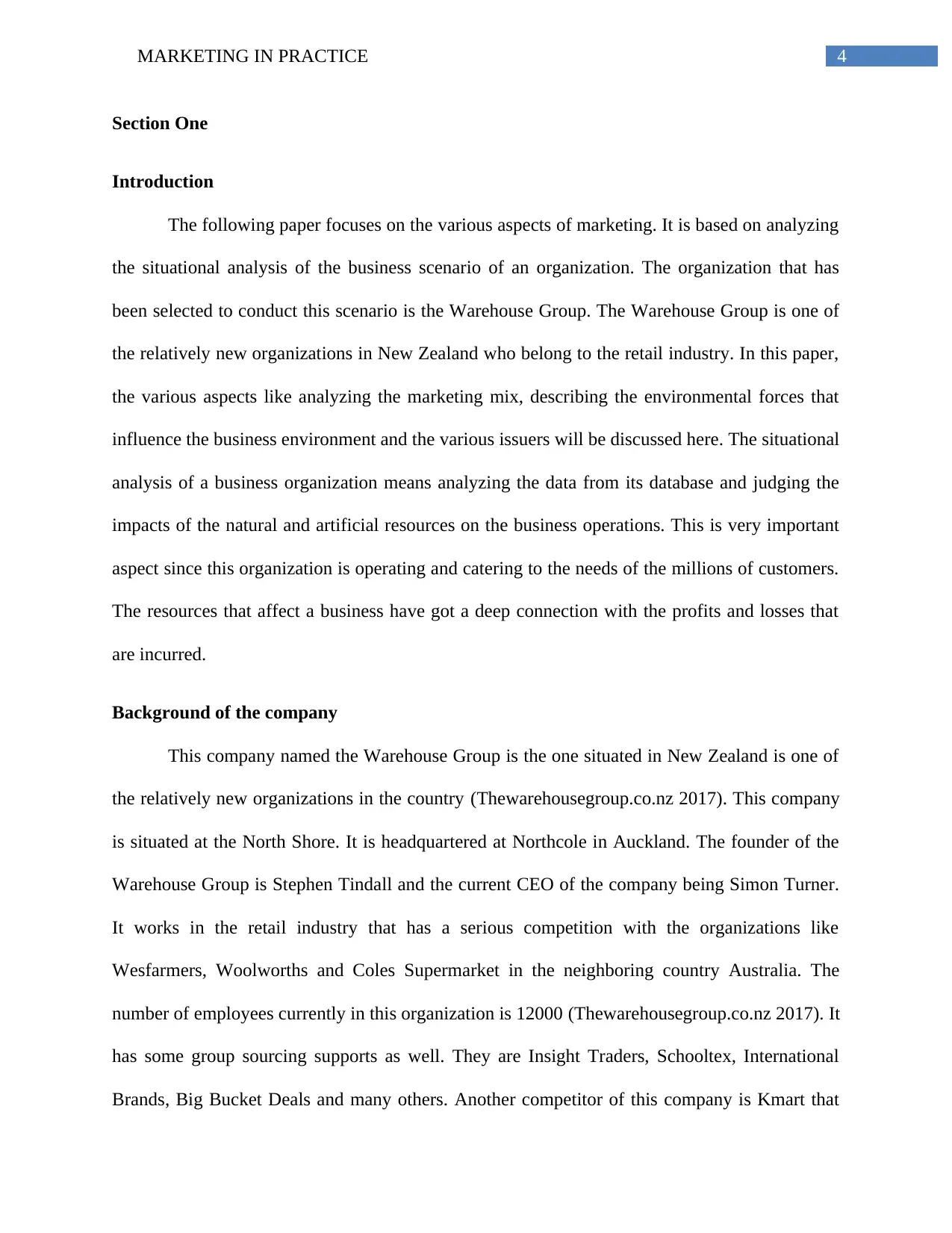
4MARKETING IN PRACTICE
Section One
Introduction
The following paper focuses on the various aspects of marketing. It is based on analyzing
the situational analysis of the business scenario of an organization. The organization that has
been selected to conduct this scenario is the Warehouse Group. The Warehouse Group is one of
the relatively new organizations in New Zealand who belong to the retail industry. In this paper,
the various aspects like analyzing the marketing mix, describing the environmental forces that
influence the business environment and the various issuers will be discussed here. The situational
analysis of a business organization means analyzing the data from its database and judging the
impacts of the natural and artificial resources on the business operations. This is very important
aspect since this organization is operating and catering to the needs of the millions of customers.
The resources that affect a business have got a deep connection with the profits and losses that
are incurred.
Background of the company
This company named the Warehouse Group is the one situated in New Zealand is one of
the relatively new organizations in the country (Thewarehousegroup.co.nz 2017). This company
is situated at the North Shore. It is headquartered at Northcole in Auckland. The founder of the
Warehouse Group is Stephen Tindall and the current CEO of the company being Simon Turner.
It works in the retail industry that has a serious competition with the organizations like
Wesfarmers, Woolworths and Coles Supermarket in the neighboring country Australia. The
number of employees currently in this organization is 12000 (Thewarehousegroup.co.nz 2017). It
has some group sourcing supports as well. They are Insight Traders, Schooltex, International
Brands, Big Bucket Deals and many others. Another competitor of this company is Kmart that
Section One
Introduction
The following paper focuses on the various aspects of marketing. It is based on analyzing
the situational analysis of the business scenario of an organization. The organization that has
been selected to conduct this scenario is the Warehouse Group. The Warehouse Group is one of
the relatively new organizations in New Zealand who belong to the retail industry. In this paper,
the various aspects like analyzing the marketing mix, describing the environmental forces that
influence the business environment and the various issuers will be discussed here. The situational
analysis of a business organization means analyzing the data from its database and judging the
impacts of the natural and artificial resources on the business operations. This is very important
aspect since this organization is operating and catering to the needs of the millions of customers.
The resources that affect a business have got a deep connection with the profits and losses that
are incurred.
Background of the company
This company named the Warehouse Group is the one situated in New Zealand is one of
the relatively new organizations in the country (Thewarehousegroup.co.nz 2017). This company
is situated at the North Shore. It is headquartered at Northcole in Auckland. The founder of the
Warehouse Group is Stephen Tindall and the current CEO of the company being Simon Turner.
It works in the retail industry that has a serious competition with the organizations like
Wesfarmers, Woolworths and Coles Supermarket in the neighboring country Australia. The
number of employees currently in this organization is 12000 (Thewarehousegroup.co.nz 2017). It
has some group sourcing supports as well. They are Insight Traders, Schooltex, International
Brands, Big Bucket Deals and many others. Another competitor of this company is Kmart that
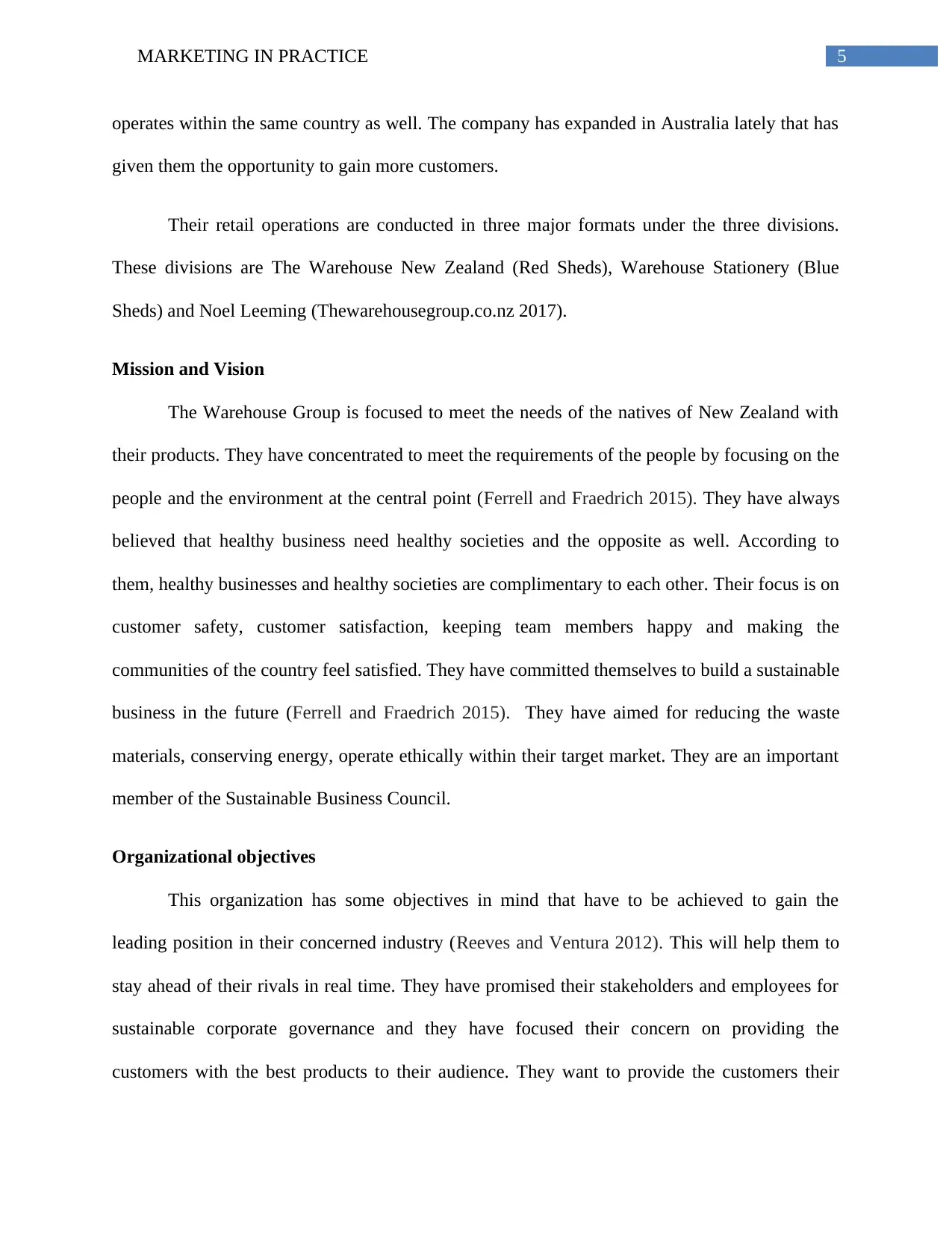
5MARKETING IN PRACTICE
operates within the same country as well. The company has expanded in Australia lately that has
given them the opportunity to gain more customers.
Their retail operations are conducted in three major formats under the three divisions.
These divisions are The Warehouse New Zealand (Red Sheds), Warehouse Stationery (Blue
Sheds) and Noel Leeming (Thewarehousegroup.co.nz 2017).
Mission and Vision
The Warehouse Group is focused to meet the needs of the natives of New Zealand with
their products. They have concentrated to meet the requirements of the people by focusing on the
people and the environment at the central point (Ferrell and Fraedrich 2015). They have always
believed that healthy business need healthy societies and the opposite as well. According to
them, healthy businesses and healthy societies are complimentary to each other. Their focus is on
customer safety, customer satisfaction, keeping team members happy and making the
communities of the country feel satisfied. They have committed themselves to build a sustainable
business in the future (Ferrell and Fraedrich 2015). They have aimed for reducing the waste
materials, conserving energy, operate ethically within their target market. They are an important
member of the Sustainable Business Council.
Organizational objectives
This organization has some objectives in mind that have to be achieved to gain the
leading position in their concerned industry (Reeves and Ventura 2012). This will help them to
stay ahead of their rivals in real time. They have promised their stakeholders and employees for
sustainable corporate governance and they have focused their concern on providing the
customers with the best products to their audience. They want to provide the customers their
operates within the same country as well. The company has expanded in Australia lately that has
given them the opportunity to gain more customers.
Their retail operations are conducted in three major formats under the three divisions.
These divisions are The Warehouse New Zealand (Red Sheds), Warehouse Stationery (Blue
Sheds) and Noel Leeming (Thewarehousegroup.co.nz 2017).
Mission and Vision
The Warehouse Group is focused to meet the needs of the natives of New Zealand with
their products. They have concentrated to meet the requirements of the people by focusing on the
people and the environment at the central point (Ferrell and Fraedrich 2015). They have always
believed that healthy business need healthy societies and the opposite as well. According to
them, healthy businesses and healthy societies are complimentary to each other. Their focus is on
customer safety, customer satisfaction, keeping team members happy and making the
communities of the country feel satisfied. They have committed themselves to build a sustainable
business in the future (Ferrell and Fraedrich 2015). They have aimed for reducing the waste
materials, conserving energy, operate ethically within their target market. They are an important
member of the Sustainable Business Council.
Organizational objectives
This organization has some objectives in mind that have to be achieved to gain the
leading position in their concerned industry (Reeves and Ventura 2012). This will help them to
stay ahead of their rivals in real time. They have promised their stakeholders and employees for
sustainable corporate governance and they have focused their concern on providing the
customers with the best products to their audience. They want to provide the customers their
⊘ This is a preview!⊘
Do you want full access?
Subscribe today to unlock all pages.

Trusted by 1+ million students worldwide
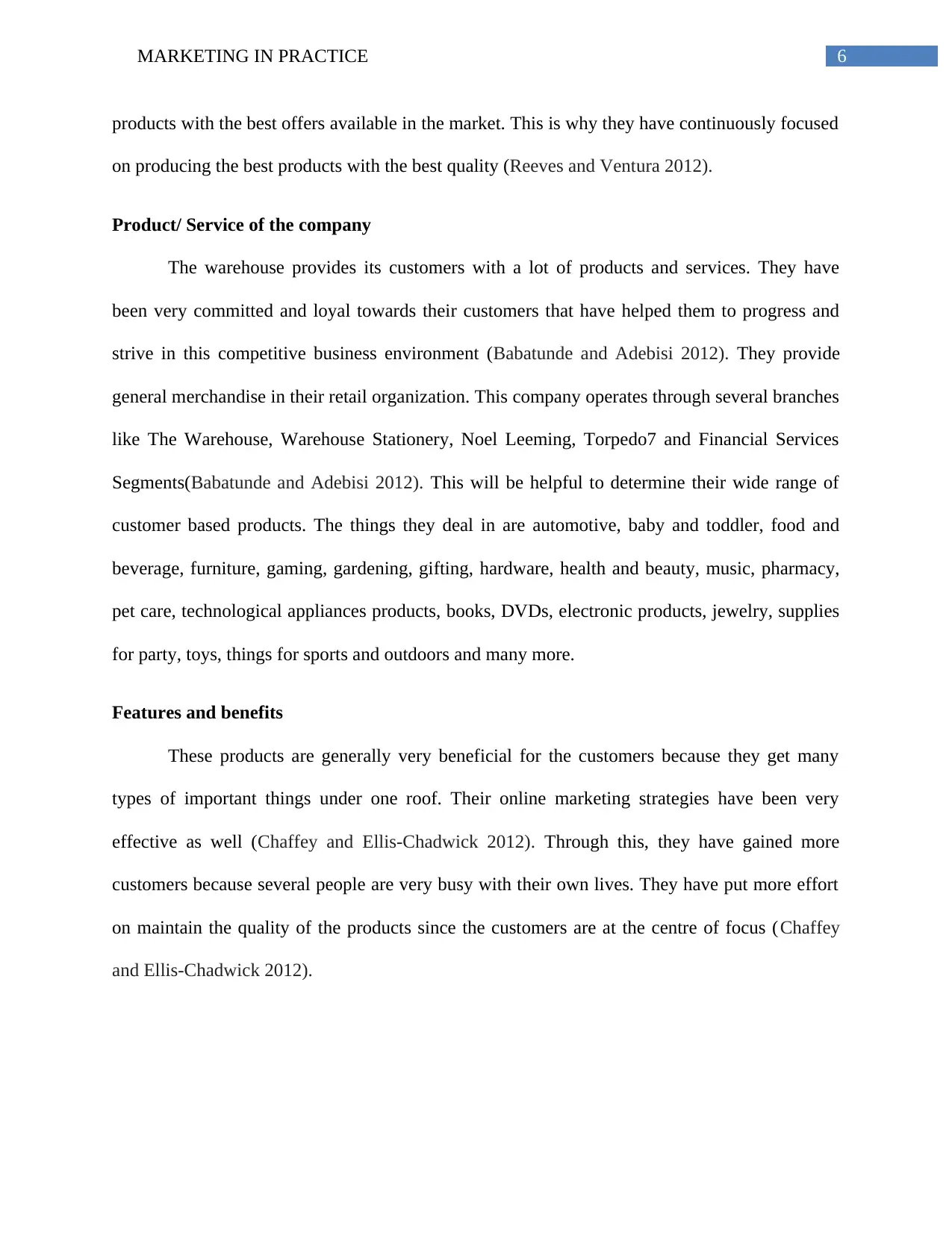
6MARKETING IN PRACTICE
products with the best offers available in the market. This is why they have continuously focused
on producing the best products with the best quality (Reeves and Ventura 2012).
Product/ Service of the company
The warehouse provides its customers with a lot of products and services. They have
been very committed and loyal towards their customers that have helped them to progress and
strive in this competitive business environment (Babatunde and Adebisi 2012). They provide
general merchandise in their retail organization. This company operates through several branches
like The Warehouse, Warehouse Stationery, Noel Leeming, Torpedo7 and Financial Services
Segments(Babatunde and Adebisi 2012). This will be helpful to determine their wide range of
customer based products. The things they deal in are automotive, baby and toddler, food and
beverage, furniture, gaming, gardening, gifting, hardware, health and beauty, music, pharmacy,
pet care, technological appliances products, books, DVDs, electronic products, jewelry, supplies
for party, toys, things for sports and outdoors and many more.
Features and benefits
These products are generally very beneficial for the customers because they get many
types of important things under one roof. Their online marketing strategies have been very
effective as well (Chaffey and Ellis-Chadwick 2012). Through this, they have gained more
customers because several people are very busy with their own lives. They have put more effort
on maintain the quality of the products since the customers are at the centre of focus (Chaffey
and Ellis-Chadwick 2012).
products with the best offers available in the market. This is why they have continuously focused
on producing the best products with the best quality (Reeves and Ventura 2012).
Product/ Service of the company
The warehouse provides its customers with a lot of products and services. They have
been very committed and loyal towards their customers that have helped them to progress and
strive in this competitive business environment (Babatunde and Adebisi 2012). They provide
general merchandise in their retail organization. This company operates through several branches
like The Warehouse, Warehouse Stationery, Noel Leeming, Torpedo7 and Financial Services
Segments(Babatunde and Adebisi 2012). This will be helpful to determine their wide range of
customer based products. The things they deal in are automotive, baby and toddler, food and
beverage, furniture, gaming, gardening, gifting, hardware, health and beauty, music, pharmacy,
pet care, technological appliances products, books, DVDs, electronic products, jewelry, supplies
for party, toys, things for sports and outdoors and many more.
Features and benefits
These products are generally very beneficial for the customers because they get many
types of important things under one roof. Their online marketing strategies have been very
effective as well (Chaffey and Ellis-Chadwick 2012). Through this, they have gained more
customers because several people are very busy with their own lives. They have put more effort
on maintain the quality of the products since the customers are at the centre of focus (Chaffey
and Ellis-Chadwick 2012).
Paraphrase This Document
Need a fresh take? Get an instant paraphrase of this document with our AI Paraphraser
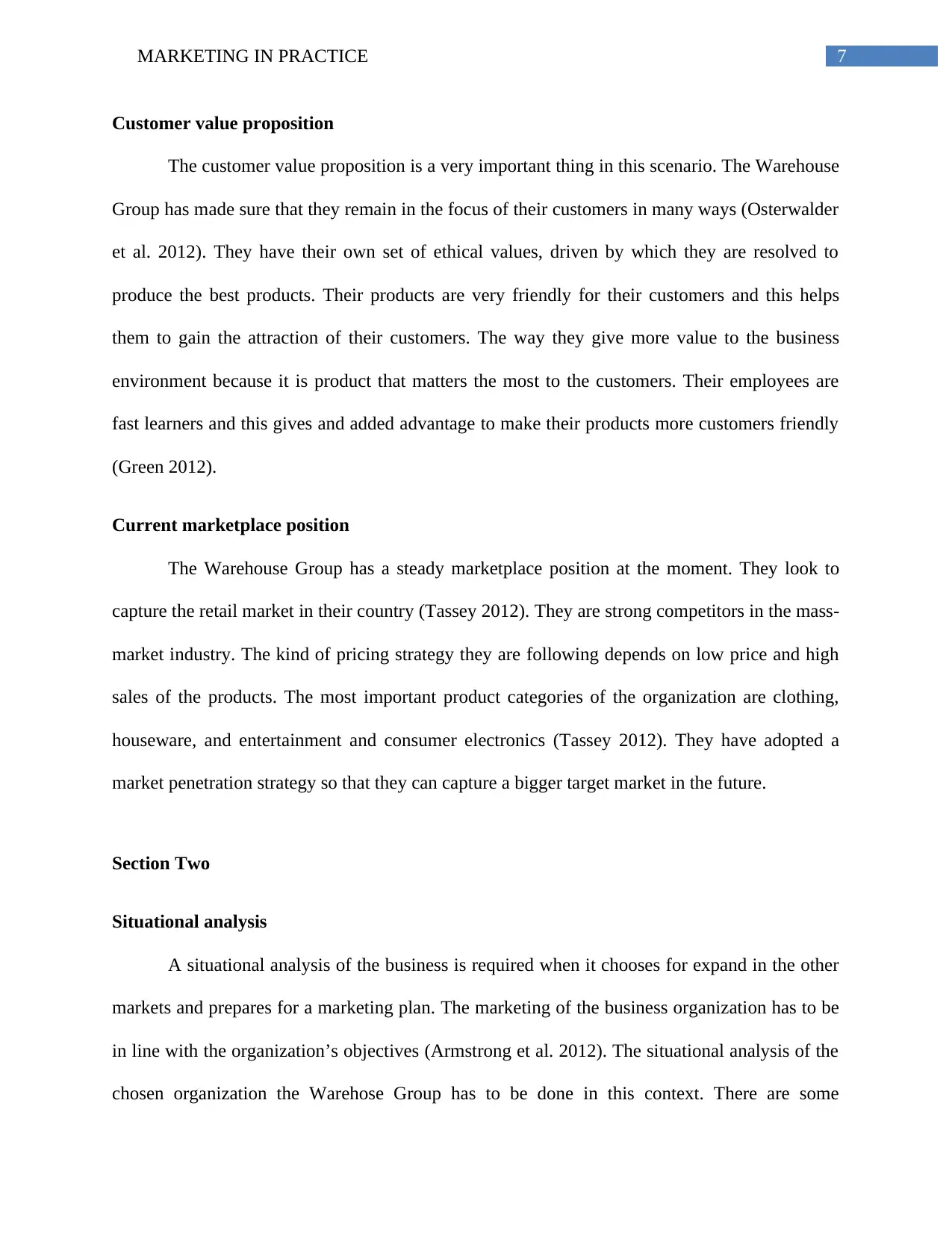
7MARKETING IN PRACTICE
Customer value proposition
The customer value proposition is a very important thing in this scenario. The Warehouse
Group has made sure that they remain in the focus of their customers in many ways (Osterwalder
et al. 2012). They have their own set of ethical values, driven by which they are resolved to
produce the best products. Their products are very friendly for their customers and this helps
them to gain the attraction of their customers. The way they give more value to the business
environment because it is product that matters the most to the customers. Their employees are
fast learners and this gives and added advantage to make their products more customers friendly
(Green 2012).
Current marketplace position
The Warehouse Group has a steady marketplace position at the moment. They look to
capture the retail market in their country (Tassey 2012). They are strong competitors in the mass-
market industry. The kind of pricing strategy they are following depends on low price and high
sales of the products. The most important product categories of the organization are clothing,
houseware, and entertainment and consumer electronics (Tassey 2012). They have adopted a
market penetration strategy so that they can capture a bigger target market in the future.
Section Two
Situational analysis
A situational analysis of the business is required when it chooses for expand in the other
markets and prepares for a marketing plan. The marketing of the business organization has to be
in line with the organization’s objectives (Armstrong et al. 2012). The situational analysis of the
chosen organization the Warehose Group has to be done in this context. There are some
Customer value proposition
The customer value proposition is a very important thing in this scenario. The Warehouse
Group has made sure that they remain in the focus of their customers in many ways (Osterwalder
et al. 2012). They have their own set of ethical values, driven by which they are resolved to
produce the best products. Their products are very friendly for their customers and this helps
them to gain the attraction of their customers. The way they give more value to the business
environment because it is product that matters the most to the customers. Their employees are
fast learners and this gives and added advantage to make their products more customers friendly
(Green 2012).
Current marketplace position
The Warehouse Group has a steady marketplace position at the moment. They look to
capture the retail market in their country (Tassey 2012). They are strong competitors in the mass-
market industry. The kind of pricing strategy they are following depends on low price and high
sales of the products. The most important product categories of the organization are clothing,
houseware, and entertainment and consumer electronics (Tassey 2012). They have adopted a
market penetration strategy so that they can capture a bigger target market in the future.
Section Two
Situational analysis
A situational analysis of the business is required when it chooses for expand in the other
markets and prepares for a marketing plan. The marketing of the business organization has to be
in line with the organization’s objectives (Armstrong et al. 2012). The situational analysis of the
chosen organization the Warehose Group has to be done in this context. There are some
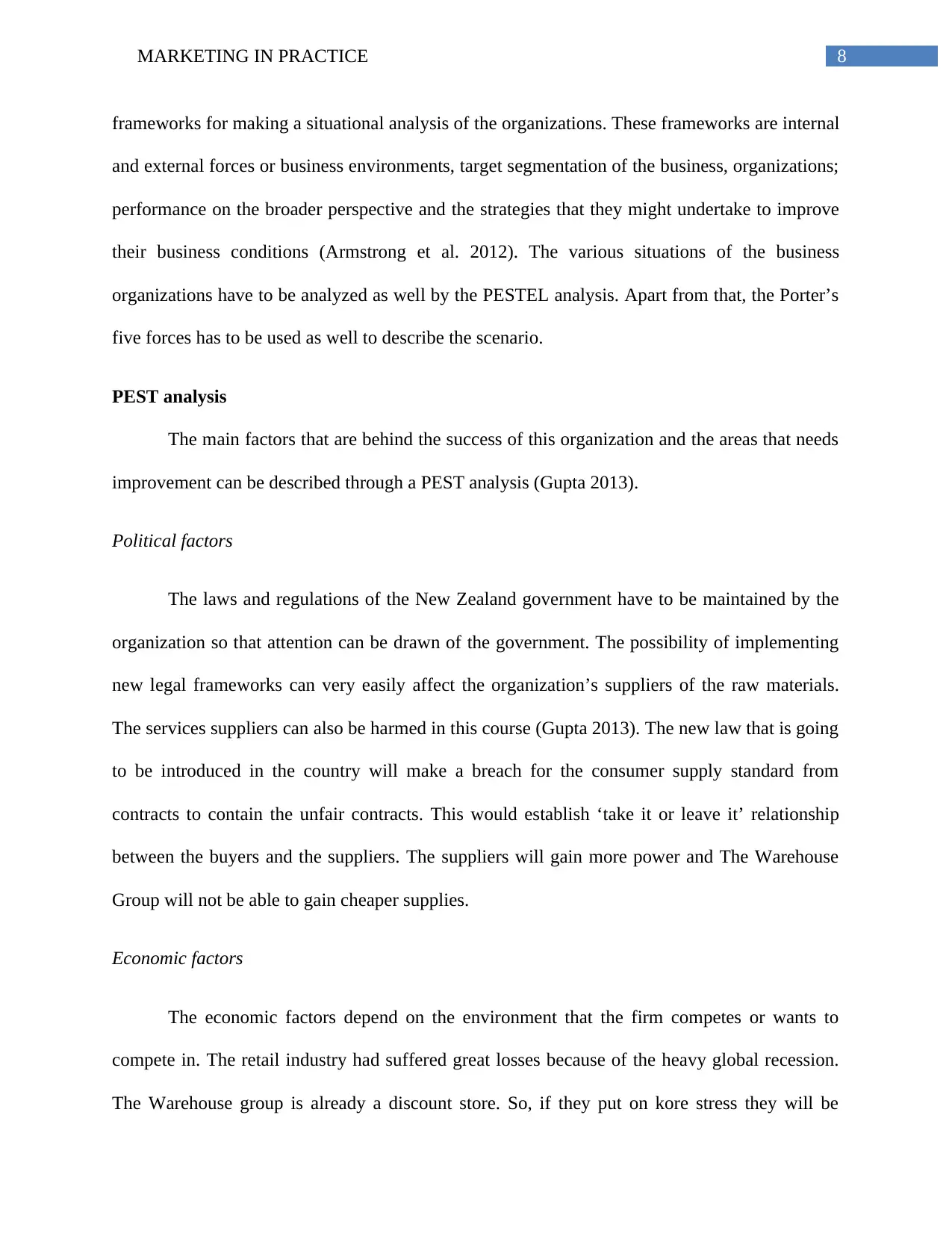
8MARKETING IN PRACTICE
frameworks for making a situational analysis of the organizations. These frameworks are internal
and external forces or business environments, target segmentation of the business, organizations;
performance on the broader perspective and the strategies that they might undertake to improve
their business conditions (Armstrong et al. 2012). The various situations of the business
organizations have to be analyzed as well by the PESTEL analysis. Apart from that, the Porter’s
five forces has to be used as well to describe the scenario.
PEST analysis
The main factors that are behind the success of this organization and the areas that needs
improvement can be described through a PEST analysis (Gupta 2013).
Political factors
The laws and regulations of the New Zealand government have to be maintained by the
organization so that attention can be drawn of the government. The possibility of implementing
new legal frameworks can very easily affect the organization’s suppliers of the raw materials.
The services suppliers can also be harmed in this course (Gupta 2013). The new law that is going
to be introduced in the country will make a breach for the consumer supply standard from
contracts to contain the unfair contracts. This would establish ‘take it or leave it’ relationship
between the buyers and the suppliers. The suppliers will gain more power and The Warehouse
Group will not be able to gain cheaper supplies.
Economic factors
The economic factors depend on the environment that the firm competes or wants to
compete in. The retail industry had suffered great losses because of the heavy global recession.
The Warehouse group is already a discount store. So, if they put on kore stress they will be
frameworks for making a situational analysis of the organizations. These frameworks are internal
and external forces or business environments, target segmentation of the business, organizations;
performance on the broader perspective and the strategies that they might undertake to improve
their business conditions (Armstrong et al. 2012). The various situations of the business
organizations have to be analyzed as well by the PESTEL analysis. Apart from that, the Porter’s
five forces has to be used as well to describe the scenario.
PEST analysis
The main factors that are behind the success of this organization and the areas that needs
improvement can be described through a PEST analysis (Gupta 2013).
Political factors
The laws and regulations of the New Zealand government have to be maintained by the
organization so that attention can be drawn of the government. The possibility of implementing
new legal frameworks can very easily affect the organization’s suppliers of the raw materials.
The services suppliers can also be harmed in this course (Gupta 2013). The new law that is going
to be introduced in the country will make a breach for the consumer supply standard from
contracts to contain the unfair contracts. This would establish ‘take it or leave it’ relationship
between the buyers and the suppliers. The suppliers will gain more power and The Warehouse
Group will not be able to gain cheaper supplies.
Economic factors
The economic factors depend on the environment that the firm competes or wants to
compete in. The retail industry had suffered great losses because of the heavy global recession.
The Warehouse group is already a discount store. So, if they put on kore stress they will be
⊘ This is a preview!⊘
Do you want full access?
Subscribe today to unlock all pages.

Trusted by 1+ million students worldwide
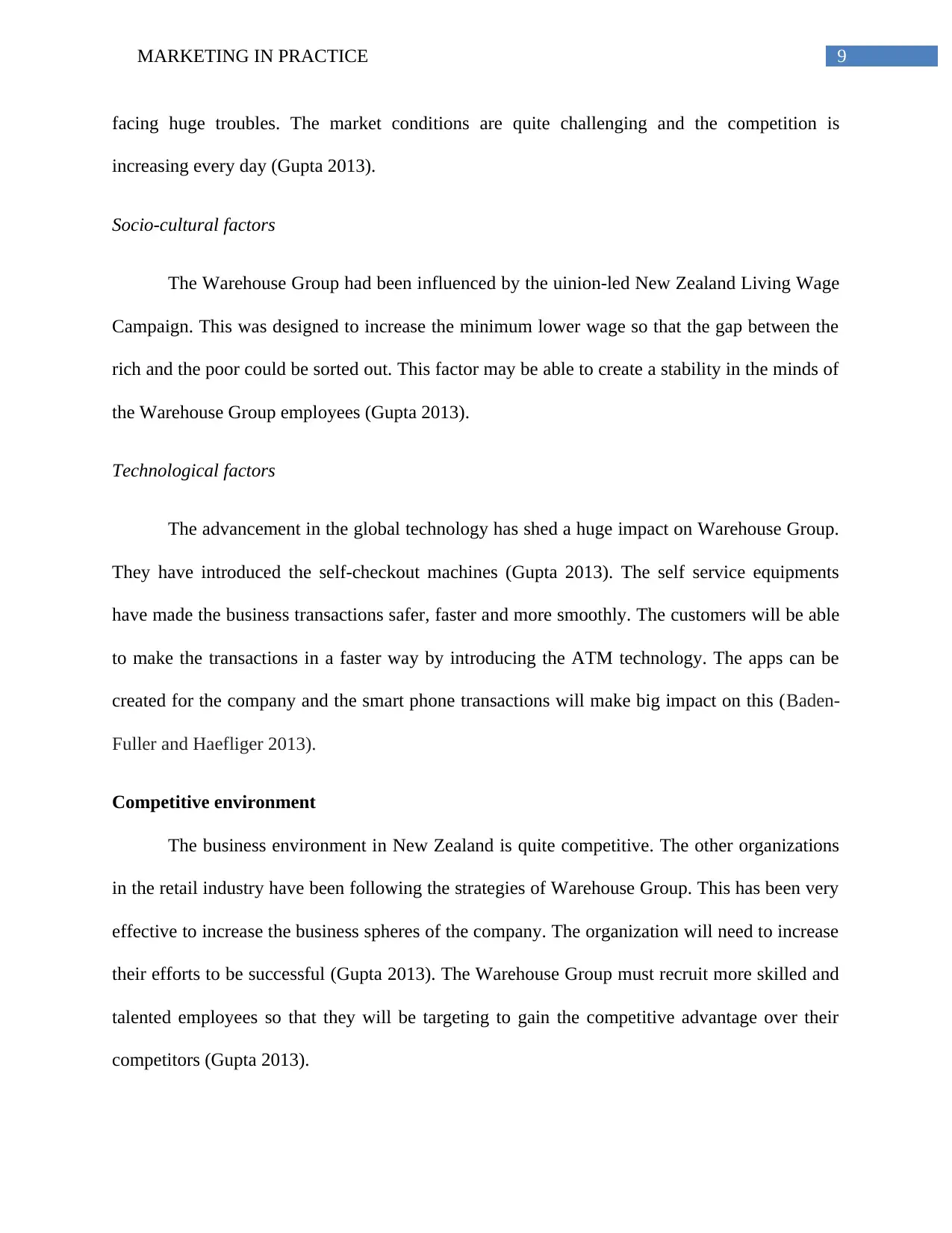
9MARKETING IN PRACTICE
facing huge troubles. The market conditions are quite challenging and the competition is
increasing every day (Gupta 2013).
Socio-cultural factors
The Warehouse Group had been influenced by the uinion-led New Zealand Living Wage
Campaign. This was designed to increase the minimum lower wage so that the gap between the
rich and the poor could be sorted out. This factor may be able to create a stability in the minds of
the Warehouse Group employees (Gupta 2013).
Technological factors
The advancement in the global technology has shed a huge impact on Warehouse Group.
They have introduced the self-checkout machines (Gupta 2013). The self service equipments
have made the business transactions safer, faster and more smoothly. The customers will be able
to make the transactions in a faster way by introducing the ATM technology. The apps can be
created for the company and the smart phone transactions will make big impact on this (Baden-
Fuller and Haefliger 2013).
Competitive environment
The business environment in New Zealand is quite competitive. The other organizations
in the retail industry have been following the strategies of Warehouse Group. This has been very
effective to increase the business spheres of the company. The organization will need to increase
their efforts to be successful (Gupta 2013). The Warehouse Group must recruit more skilled and
talented employees so that they will be targeting to gain the competitive advantage over their
competitors (Gupta 2013).
facing huge troubles. The market conditions are quite challenging and the competition is
increasing every day (Gupta 2013).
Socio-cultural factors
The Warehouse Group had been influenced by the uinion-led New Zealand Living Wage
Campaign. This was designed to increase the minimum lower wage so that the gap between the
rich and the poor could be sorted out. This factor may be able to create a stability in the minds of
the Warehouse Group employees (Gupta 2013).
Technological factors
The advancement in the global technology has shed a huge impact on Warehouse Group.
They have introduced the self-checkout machines (Gupta 2013). The self service equipments
have made the business transactions safer, faster and more smoothly. The customers will be able
to make the transactions in a faster way by introducing the ATM technology. The apps can be
created for the company and the smart phone transactions will make big impact on this (Baden-
Fuller and Haefliger 2013).
Competitive environment
The business environment in New Zealand is quite competitive. The other organizations
in the retail industry have been following the strategies of Warehouse Group. This has been very
effective to increase the business spheres of the company. The organization will need to increase
their efforts to be successful (Gupta 2013). The Warehouse Group must recruit more skilled and
talented employees so that they will be targeting to gain the competitive advantage over their
competitors (Gupta 2013).
Paraphrase This Document
Need a fresh take? Get an instant paraphrase of this document with our AI Paraphraser
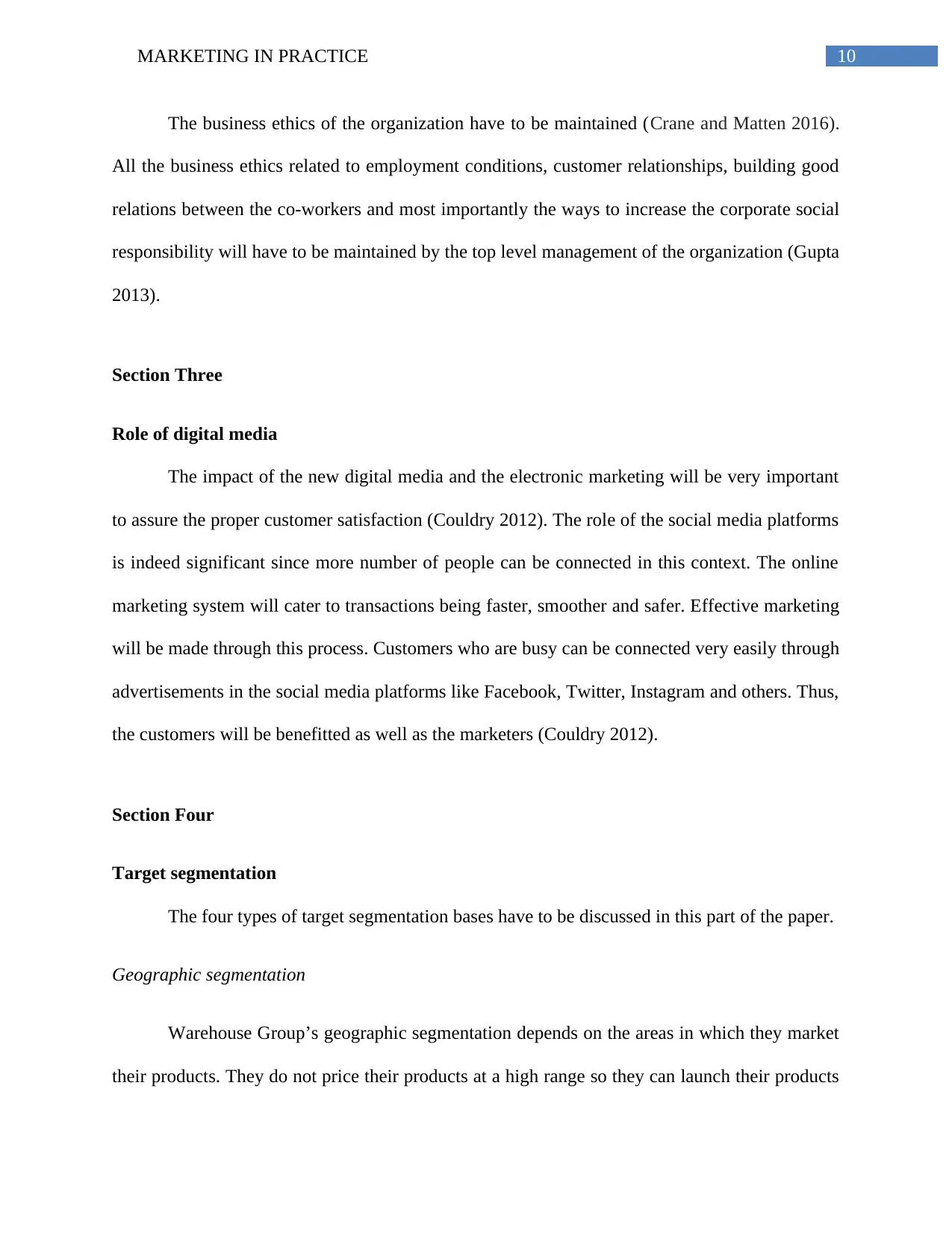
10MARKETING IN PRACTICE
The business ethics of the organization have to be maintained (Crane and Matten 2016).
All the business ethics related to employment conditions, customer relationships, building good
relations between the co-workers and most importantly the ways to increase the corporate social
responsibility will have to be maintained by the top level management of the organization (Gupta
2013).
Section Three
Role of digital media
The impact of the new digital media and the electronic marketing will be very important
to assure the proper customer satisfaction (Couldry 2012). The role of the social media platforms
is indeed significant since more number of people can be connected in this context. The online
marketing system will cater to transactions being faster, smoother and safer. Effective marketing
will be made through this process. Customers who are busy can be connected very easily through
advertisements in the social media platforms like Facebook, Twitter, Instagram and others. Thus,
the customers will be benefitted as well as the marketers (Couldry 2012).
Section Four
Target segmentation
The four types of target segmentation bases have to be discussed in this part of the paper.
Geographic segmentation
Warehouse Group’s geographic segmentation depends on the areas in which they market
their products. They do not price their products at a high range so they can launch their products
The business ethics of the organization have to be maintained (Crane and Matten 2016).
All the business ethics related to employment conditions, customer relationships, building good
relations between the co-workers and most importantly the ways to increase the corporate social
responsibility will have to be maintained by the top level management of the organization (Gupta
2013).
Section Three
Role of digital media
The impact of the new digital media and the electronic marketing will be very important
to assure the proper customer satisfaction (Couldry 2012). The role of the social media platforms
is indeed significant since more number of people can be connected in this context. The online
marketing system will cater to transactions being faster, smoother and safer. Effective marketing
will be made through this process. Customers who are busy can be connected very easily through
advertisements in the social media platforms like Facebook, Twitter, Instagram and others. Thus,
the customers will be benefitted as well as the marketers (Couldry 2012).
Section Four
Target segmentation
The four types of target segmentation bases have to be discussed in this part of the paper.
Geographic segmentation
Warehouse Group’s geographic segmentation depends on the areas in which they market
their products. They do not price their products at a high range so they can launch their products
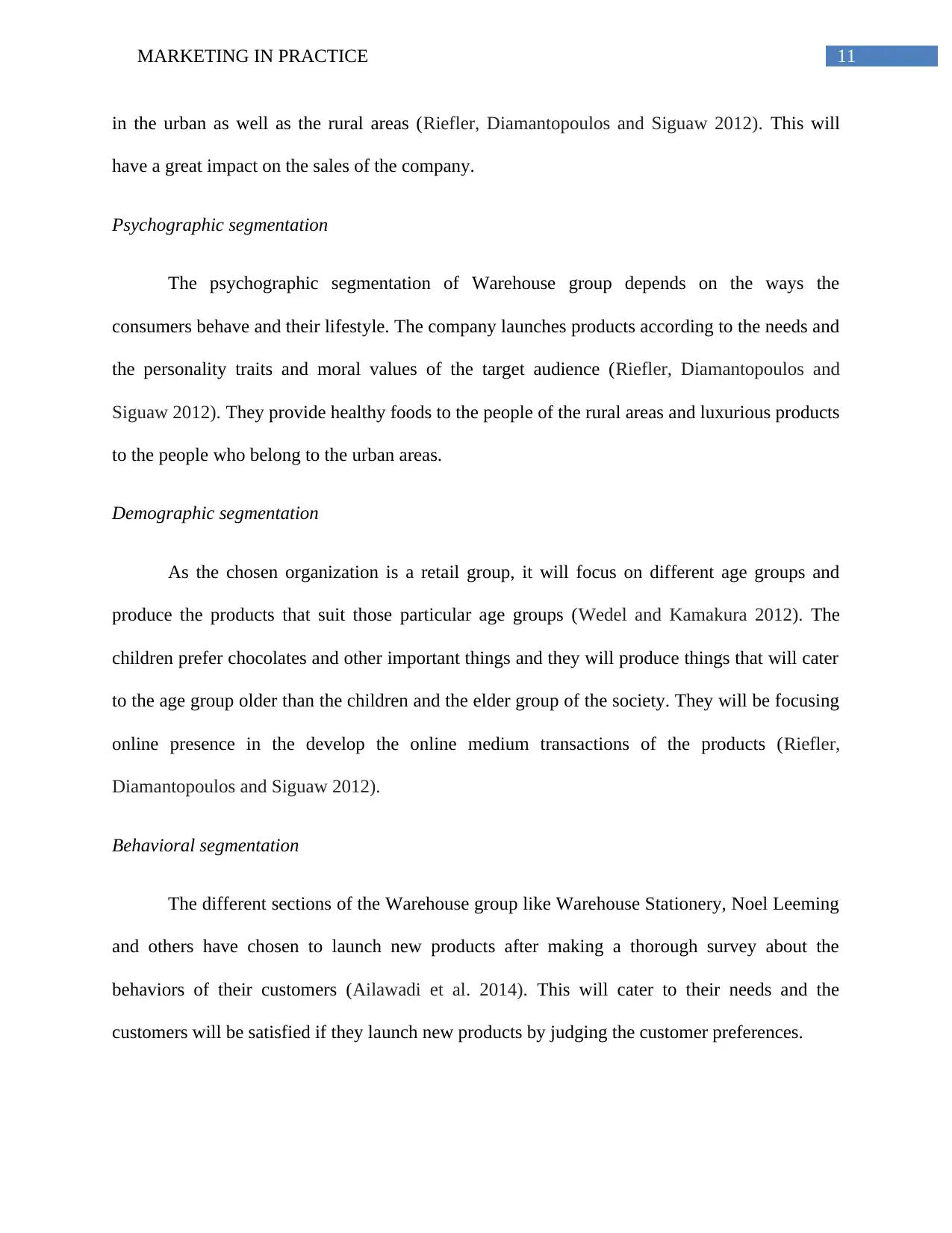
11MARKETING IN PRACTICE
in the urban as well as the rural areas (Riefler, Diamantopoulos and Siguaw 2012). This will
have a great impact on the sales of the company.
Psychographic segmentation
The psychographic segmentation of Warehouse group depends on the ways the
consumers behave and their lifestyle. The company launches products according to the needs and
the personality traits and moral values of the target audience (Riefler, Diamantopoulos and
Siguaw 2012). They provide healthy foods to the people of the rural areas and luxurious products
to the people who belong to the urban areas.
Demographic segmentation
As the chosen organization is a retail group, it will focus on different age groups and
produce the products that suit those particular age groups (Wedel and Kamakura 2012). The
children prefer chocolates and other important things and they will produce things that will cater
to the age group older than the children and the elder group of the society. They will be focusing
online presence in the develop the online medium transactions of the products (Riefler,
Diamantopoulos and Siguaw 2012).
Behavioral segmentation
The different sections of the Warehouse group like Warehouse Stationery, Noel Leeming
and others have chosen to launch new products after making a thorough survey about the
behaviors of their customers (Ailawadi et al. 2014). This will cater to their needs and the
customers will be satisfied if they launch new products by judging the customer preferences.
in the urban as well as the rural areas (Riefler, Diamantopoulos and Siguaw 2012). This will
have a great impact on the sales of the company.
Psychographic segmentation
The psychographic segmentation of Warehouse group depends on the ways the
consumers behave and their lifestyle. The company launches products according to the needs and
the personality traits and moral values of the target audience (Riefler, Diamantopoulos and
Siguaw 2012). They provide healthy foods to the people of the rural areas and luxurious products
to the people who belong to the urban areas.
Demographic segmentation
As the chosen organization is a retail group, it will focus on different age groups and
produce the products that suit those particular age groups (Wedel and Kamakura 2012). The
children prefer chocolates and other important things and they will produce things that will cater
to the age group older than the children and the elder group of the society. They will be focusing
online presence in the develop the online medium transactions of the products (Riefler,
Diamantopoulos and Siguaw 2012).
Behavioral segmentation
The different sections of the Warehouse group like Warehouse Stationery, Noel Leeming
and others have chosen to launch new products after making a thorough survey about the
behaviors of their customers (Ailawadi et al. 2014). This will cater to their needs and the
customers will be satisfied if they launch new products by judging the customer preferences.
⊘ This is a preview!⊘
Do you want full access?
Subscribe today to unlock all pages.

Trusted by 1+ million students worldwide
1 out of 20
Related Documents
Your All-in-One AI-Powered Toolkit for Academic Success.
+13062052269
info@desklib.com
Available 24*7 on WhatsApp / Email
![[object Object]](/_next/static/media/star-bottom.7253800d.svg)
Unlock your academic potential
Copyright © 2020–2025 A2Z Services. All Rights Reserved. Developed and managed by ZUCOL.





